Minds On
Starlight, star bright
Have you ever experienced a night sky filled with stars?
Explore the following video clip. What do you notice? What do you wonder? Record your thoughts in a method of your choice.
Using the previous video clip for inspiration, describe what you know and wonder about stars.
You might choose to describe a time that you encountered stars in writing, through an audio or video recording, or in another method of your choice.
Action
What is a star?
Explore the following TVO Space Kids video to help us answer the question: what is a star?
Consider the information shared in the previous video clip. Record two to three (2-3) facts about stars that you learned from the video clip in a method of your choice.
Press ‘Hint’ to access examples of facts about stars from the video.
- Stars are oversized, burning balls of gas in space.
- Stars come in various sizes.
- The Sun looks large in comparison to stars in the night sky because Earth is closer to the Sun.
- Some of the largest and hottest stars in the universe are called “super-giants”.
- There are 10 times more stars in the night sky than there are grains of sand in the world’s deserts and beaches.
The properties of light
Understanding the properties of light can help guide our understanding of stars.
Explore the following interactive checklist to learn about the different properties of light.
Light…
Learning check
After you have explored the interactive checklist, review your learning by responding to the following true or false statements. Press the buttons to select the most appropriate response.
Constellations
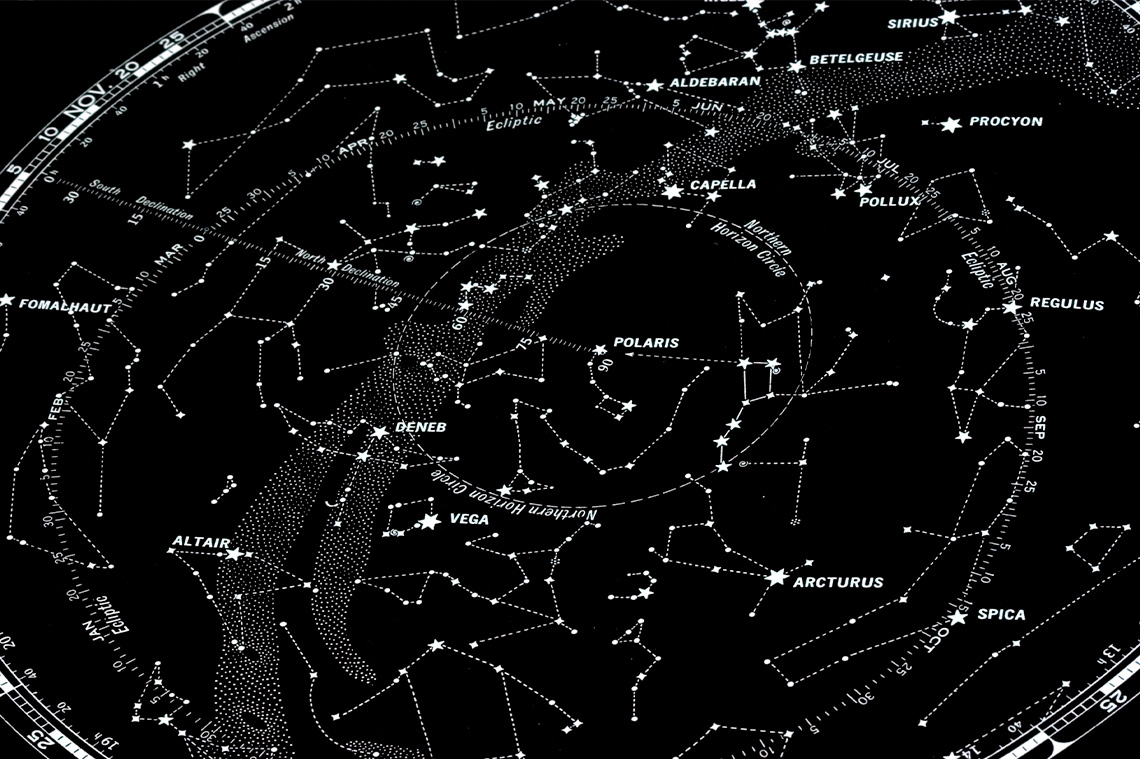
Constellations are stars that are grouped together because they appear to form a shape or object in the sky when they are connected by imaginary lines.
Constellations are often given names and hold connections to folklore, creation stories, or histories, depending on the culture naming them. Many cultures and peoples have their own connections to groupings of stars, and their own names for them.
Check out this video entitled “Storybook in the Sky” to learn more about different cultural communities and the stories they tell about the stars in the night sky.
Pause and Reflect
Pause and reflect
- Why is the title of this video about constellations called “Storybook in the Sky”?
- What are some of the names and stories that were shared about the Big Dipper?
- Do you know any other stories about this grouping of stars?
Record your ideas in a method of your choice.
Star stories
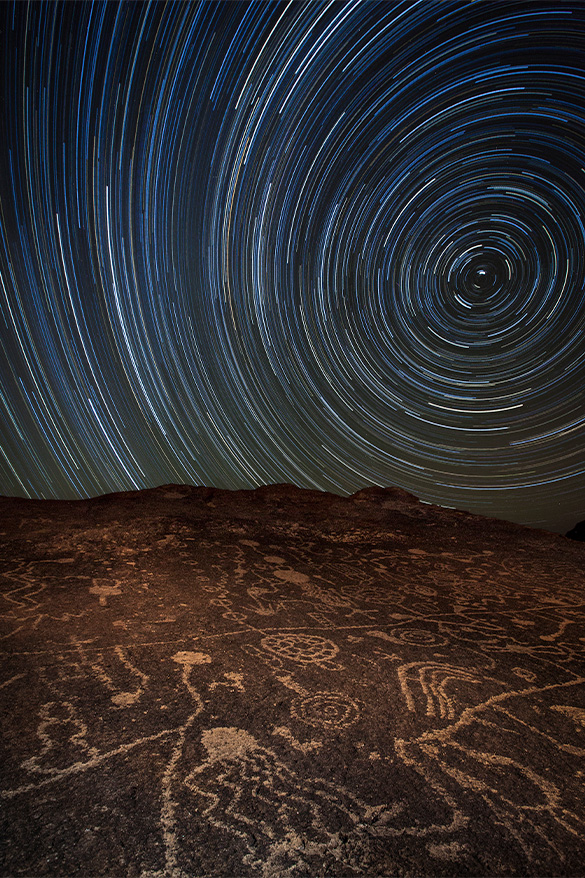
Ancient Indigenous illustrations known as “petroglyphs” etched into rockface near Bishop, California.
Since before time was measured with clocks and calendars, Indigenous peoples have been observing the stars and other night sky patterns. Stars have been used to tell time, and stars have been used as maps to help with directions and wayfinding.
Traditionally, many, but not all, First Nation, Métis and Inuit communities were nomadic, which means they travelled from place to place following the seasons, and animals. They used the stars in the night sky to measure time as well as to navigate their journey.
In many Indigenous communities, traditional knowledge is shared through an oral tradition of storytelling. Creation stories hold knowledge and are used to teach, entertain, connect and share the ways of knowing, being and doing from a specific community or nation.
Indigenous knowledges
Indigenous knowledges include perspectives, practices and beliefs that have been passed from generation to generation through stories, ceremonies, songs, cultural teachings and more. These teachings, and ways of knowing, being, and doing, are shared by Elders and Knowledge Keepers, as well as community members, and are deeply connected with land.
It is important to remember that there are diverse and multiple perspectives within First Nations, Métis and Inuit communities. There are, however, some shared understandings of the universe and human relationships, which include:
- strong connection to spirit
- deeply rooted in a community’s specific place
- recognition that everything is related
- emphasis on reciprocity with the environment (this means that the environment and communities within it benefit from each other)
Press the following tabs to access more detailed information on Indigenous knowledges.
Indigenous ways of knowing include a holistic approach to understanding the relationship of living beings (including humans) with one another and with their environment. There is an understanding of kinship that recognizes how we are all interconnected. Every living being is alive with spirit, and treated with respect.
For centuries, Indigenous knowledges and ways of knowing have been erased or silenced by ongoing colonization. As part of the work towards reconciliation and healing, it is critical to honour and include multiple perspectives to not only strengthen and share understanding but also approach problems with more creative solutions.
Colonization also impacts how and what is learned and taught in schools. When teaching about astronomy, many schools have used a Western approach, which centers the stories of Greek and Roman mythologies. In this learning activity, we will explore how Indigenous knowledges and perspectives from this land can help scientists and astronomers to “see” and learn from the night sky in a different way.
Two-Eyed Seeing
“Etuaptmumk is the Mi’kmaw word for Two-Eyed Seeing. We often explain
Etuaptmumk–Two-Eyed Seeing by saying it refers to learning to see from one eye with the strengths of Indigenous knowledges and ways of knowing, and from the other eye with the strengths of Western knowledges and
ways of knowing … and learning to use both these eyes together, for the benefit of all.”
- Mi’kmaw Elder Albert Marshall
Mi’kmaw Elder Albert Marshall developed the guiding principle of Two-Eyed Seeing to describe how Western and Indigenous knowledges and perspectives can work together to share learning and understandings. By honouring multiple perspectives as a gift, Two-Eyed Seeing can help us to improve our understanding and relationships with each other, and with the Earth.
Wilfred Buck: “The Star Guy”
Wilfred Buck is an Indigenous astronomer, educator, and Knowledge Keeper from the Opaskwayak Cree Nation in Northern Manitoba. He is the author of Tipiskawi Kisik: Night Sky Star Stories.
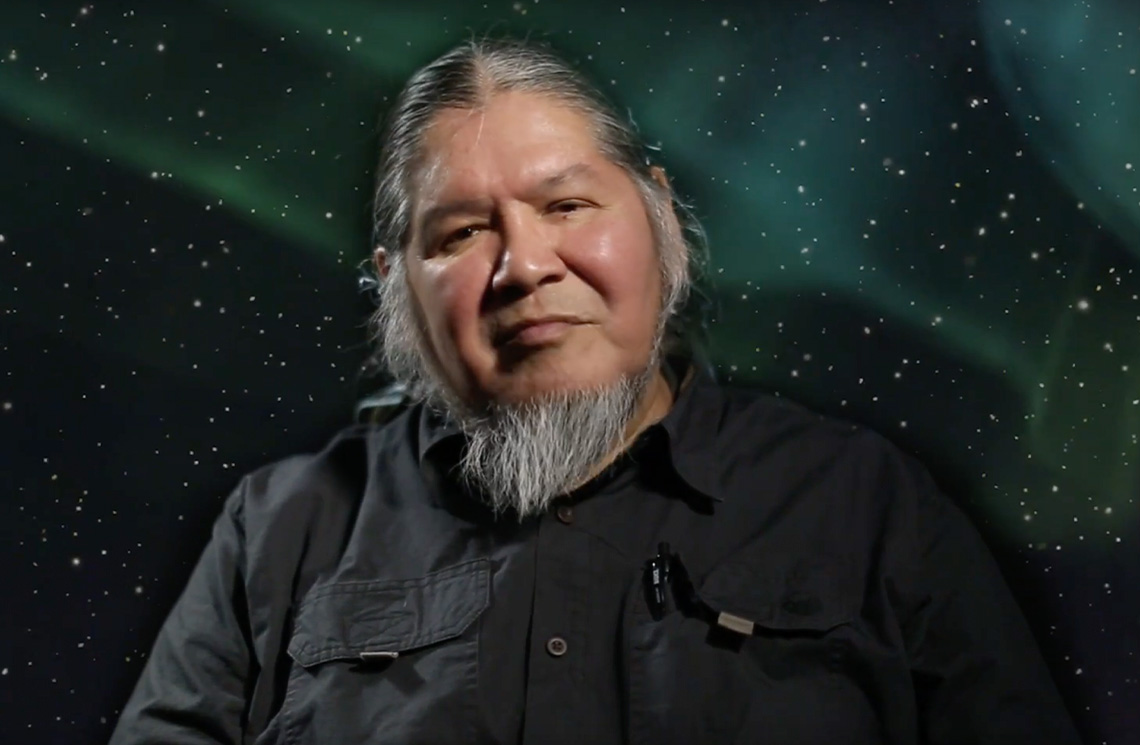
Wilfred Buck
Wilfred Buck is known as “The Star Guy” because of his extensive knowledge. He uses the Two-Eyed Seeing approach to share Indigenous and Western teachings about the night sky. In this video, Wilfred Buck shares information about important stars that can be found in the northern hemisphere. The North Star, which is known in Western teachings as “Polaris” has been used by travellers as a navigational tool since time immemorial.
After exploring the video and examining the information shared about Wilfred Buck, review your learning by answering the following multiple choice questions:
Wilfred Buck explains that the North Star has several names in the Cree language. It is sometimes called Keewatin, which means “Going Home Star”, or Ekakatchet Atchakos, which means “It Stands Still”. Keewatin has always been used by Cree travellers to navigate and guide them home.
Another group of bright stars found in the northern hemisphere is known in Western teachings as “The Big Dipper”. Wilfred Buck shares how travellers can use the Big Dipper, which is part of a larger constellation, to find Keewatin or Polaris.
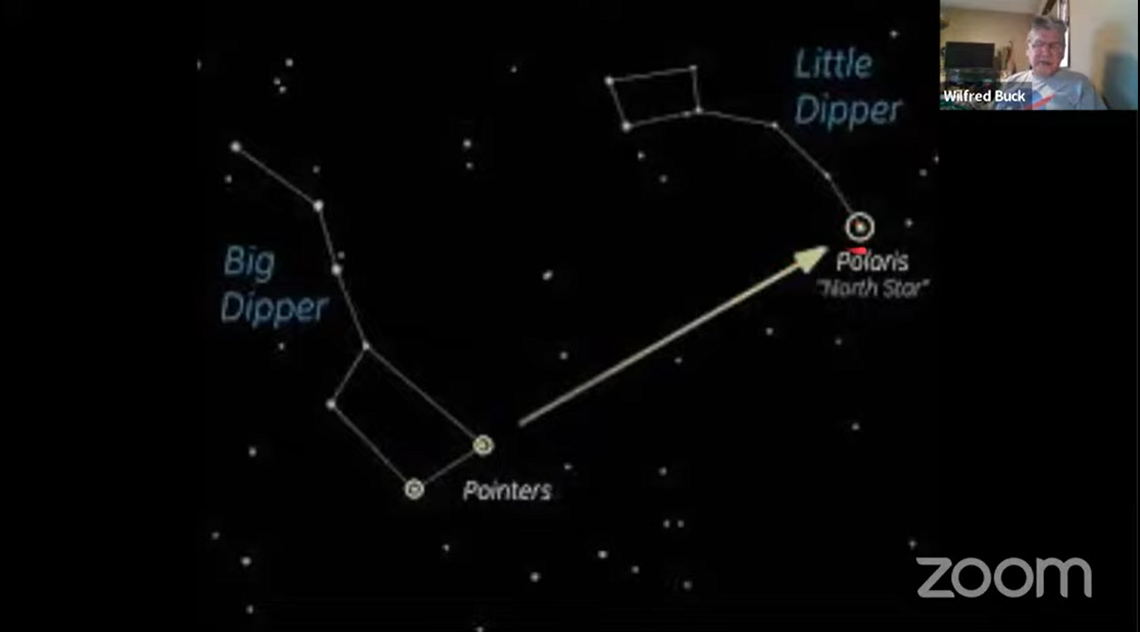
This is a screenshot from a presentation. There is a small image of Wilfred Buck in the top right corner. He is sharing a diagram of a group of stars that are labelled the Big Dipper and the Little Dipper. There is an arrow drawn from the two pointer stars on the end of the Big Dipper that leads in a straight line towards the handle of the Little Dipper. This star is labelled Polaris or “North Star”.
Pause and Reflect
Pause and reflect
- How might knowing where to find Keewatin or the North Star help travellers to guide their way home?
Record your ideas on paper, digitally, as an audio-recording, or in another method of your choice.
Press ‘Possible Answer’ to access one example of a response to the previous question.
The night sky can be used as a compass to help travellers orient themselves in the direction of the north. The North Star is the only star in the sky that is fixed and does not move. Wilfred Buck describes how travellers can use the stars in the sky as a protractor, and use angles to orient themselves in relationship to North.
The Big Dipper
Let’s return to the image from the Minds On activity.
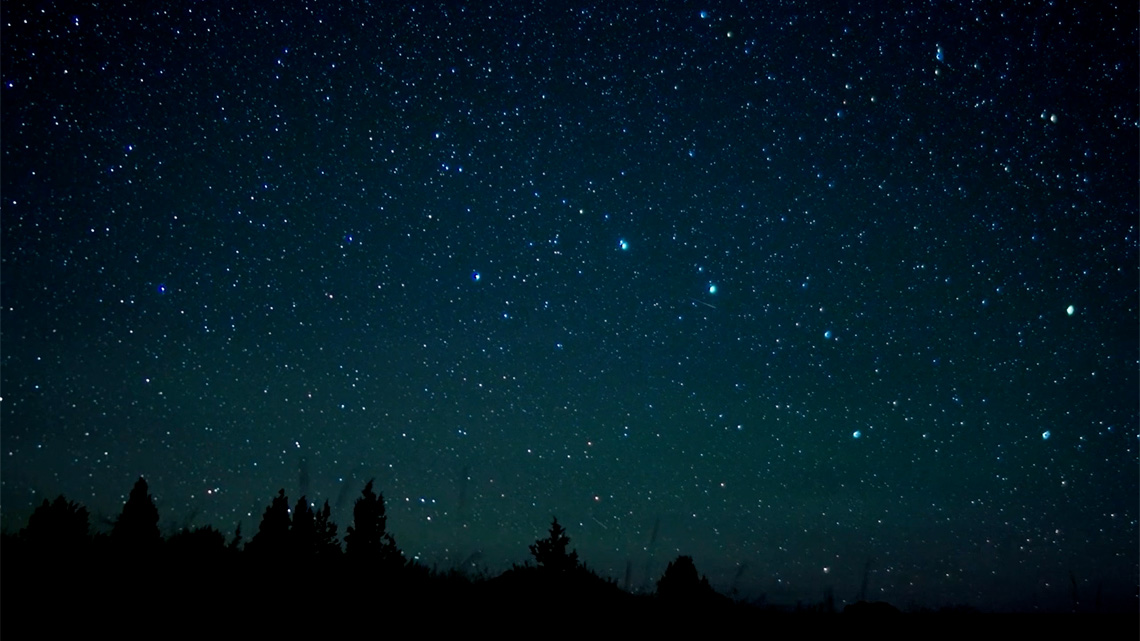
This grouping of stars is known by many different names.
Let’s explore.
Press the following tabs to explore two different Indigenous stories about the same group of stars.
The Haudenosaunee Confederacy live on their traditional territories southeast of the Great Lakes. The Haudenosaunee include the following nations: Mohawk, Oneida, Onondaga, Cayuga, Seneca and the Tuscarora.
 Description
Description
This is a map that covers parts of Ontario, Quebec, and the United States. The map shows territories of the Six Nations of the Haudenosaunee, after they were relocated by the British Crown.
The six Nations displayed on the map are: the Mohawk, Onondaga, Tuscarora, Oneida, Seneca, and Haudenosaunee Federal Territory.
There are two Mohawk territories near Montreal, three in the United States, and another one in the far west around Georgian Bay. There is also a Mohawk territory near the Bay of Quinte on Lake Ontario.
The Onondaga have one territory in the United States.
The Tuscarora have one territory near Niagara Falls.
The Haudenosaunee Federal Territory is in Southeast Ontario.
The Oneida have two territories. One Oneida territory is in the United States, and the other is far away in Southern Ontario.
There are three Seneca territories in the United States.
William Morin is a former University of Sudbury Indigenous Studies professor and Anishinaabek/Ojibway artist. He co-wrote an article about how different Indigenous nations describe the pattern of stars known in Western teachings as the Big Dipper.
According to Haudenosaunee tradition, the four stars of the rectangle form the shape of a bear, while the other three stars represent three hunters actively engaged in the hunt. The first hunter, closest to the bear, is Robin (a completely black-coloured bird). The next star/hunter is Chickadee, and the farthest hunter/star from the bear is Moosebird.
The following image demonstrates how the Great Bear moves around the sky during the different seasons. Polaris, the North Star, is in the centre.
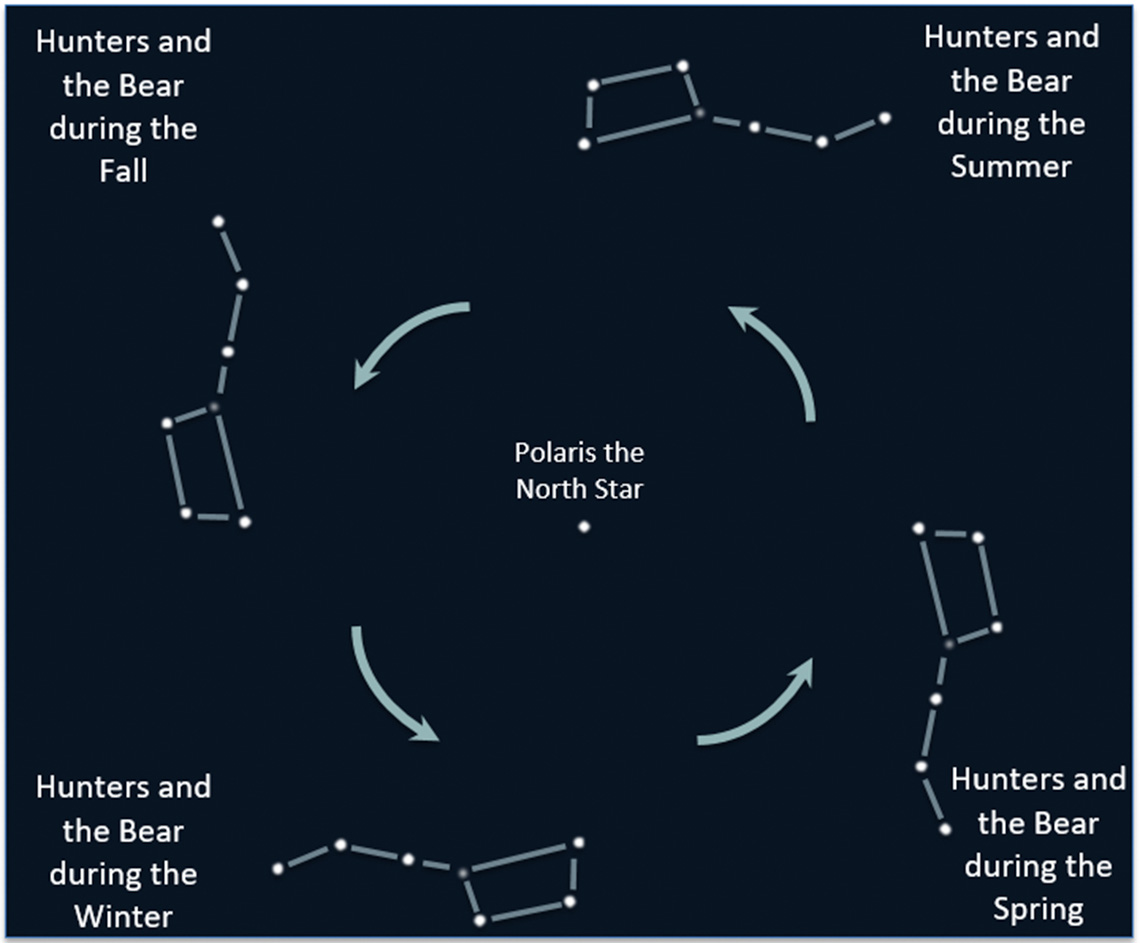
Explore the following description of this star story from Ontario Parks:
“The trio pursue the bear from spring to fall, with the bear constantly outpacing the hunters. However, in the fall the tired bear stops and stands to fight the hunters. At this point, Robin shoots an arrow at the bear and wounds it. The blood from the bear falls onto the trees, explaining why they change colour in the fall. Likewise, the bear’s blood also completely covers Robin. While Robin does his best to shake the blood off, a red streak remains down his midsection permanently, explaining why robins today have red breasts.”
Fred Sangris is a respected Elder and member of the Yellowknives Dene First Nation, and the Chief of the community of Ndilǫ, Northwest Territories.
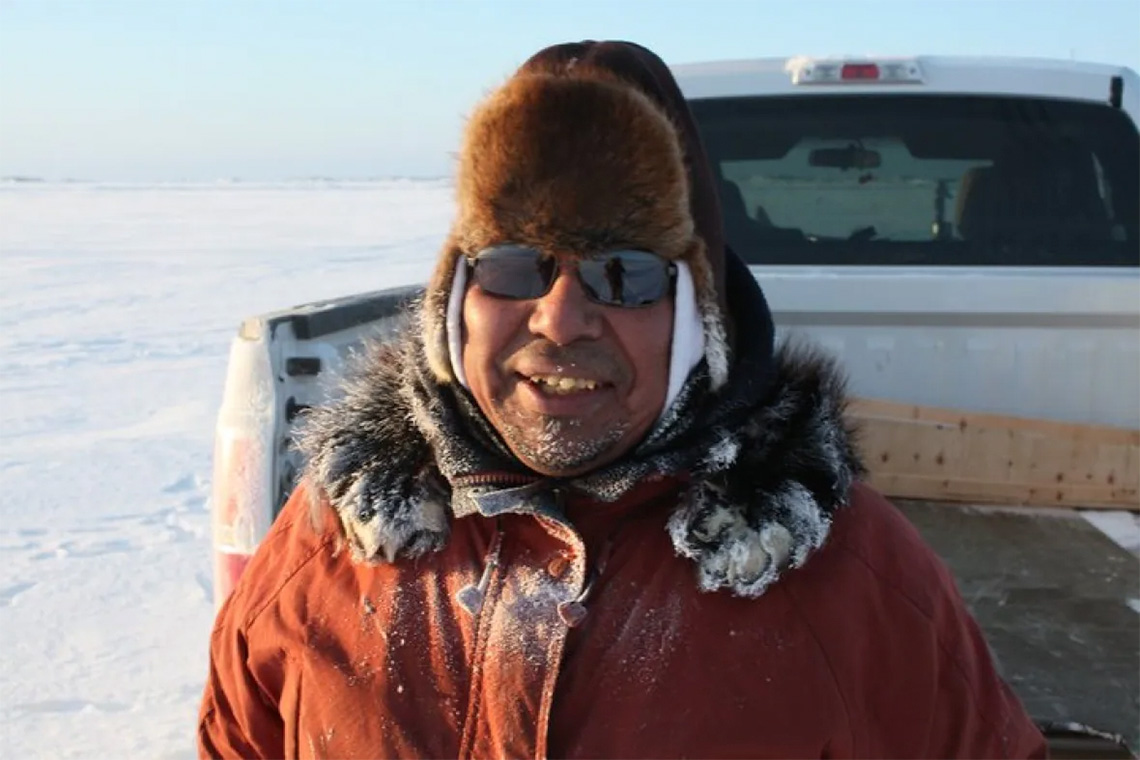
When Elder Fred Sangris was a young child, his grandfather taught him how to use the stars in the night sky to navigate and guide him while he was travelling to hunt and trap animals. He also learned how to use the stars as a clock and a calendar.
Explore the following audio clip and description as Elder Fred Sangris acknowledges the importance of sharing Dene cultural knowledge through stories, and recounts how he learned the story about “The Man in the Sky” from his grandfather.
Fred Sangris
Elder Fred Sangris tells the story of Yamoòzha, a traveller figure whose spirit went up into the sky. Yamoòzha was a sacred person who lived in a magical, spiritual world. He did important work to keep the community safe from harm. Yamoòzha encountered someone who was jealous of his magic and status as a shaman (which is the name of spiritual leaders, healers and Knowledge Keepers in Indigenous communities), and chased him all over the land. Yamoòzha escaped by going into the sky. He was shot in the back with an arrow.
Elder Fred Sangris explains that Yamoòzha remains in the sky, watching over the Dene people. He reminds them to honour Dene law, which includes living in relationships of respect and reciprocity with all living things, including land.
Explore the following image of the Man in the Sky constellation:
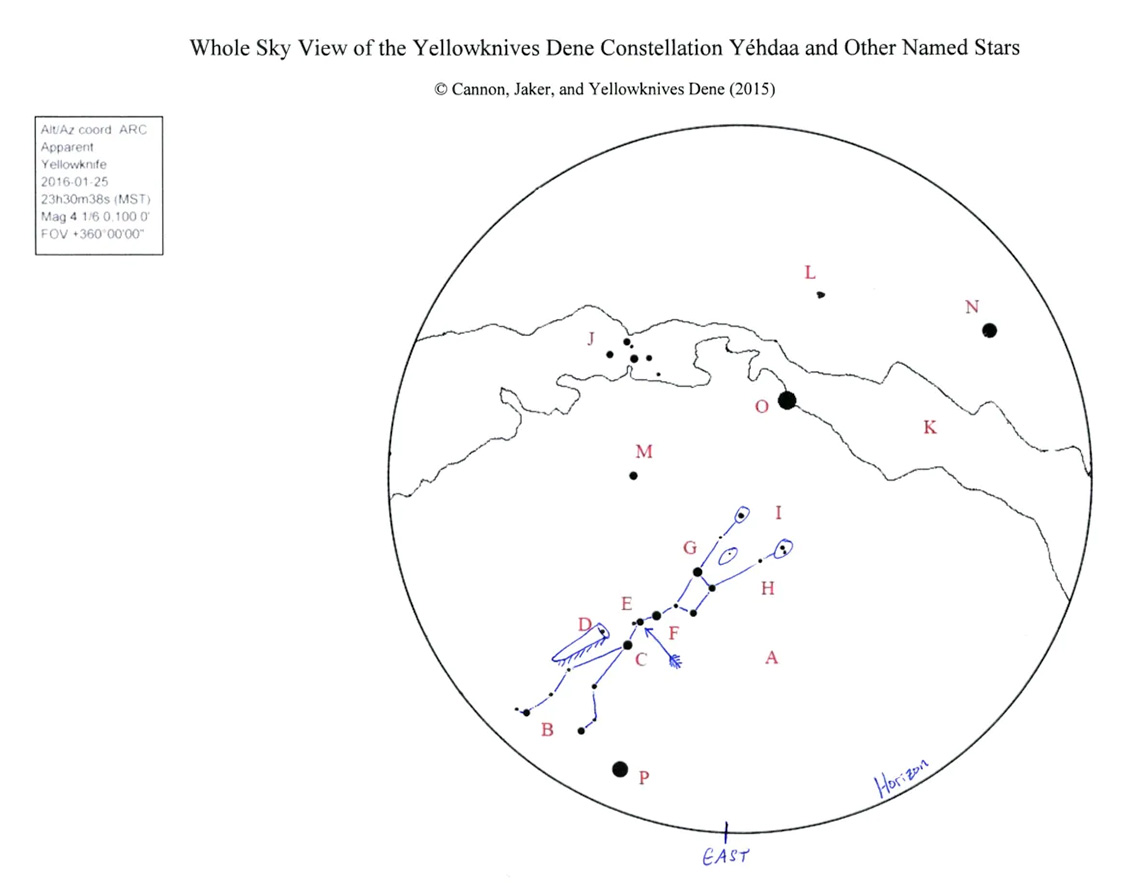
In the above image, the figure of Yamoòzha is formed with the stars known as the Big Dipper. Yamoòzha is reaching up with his arms. His body is bent because he has been hit in the back with an arrow.
In the image, observe how the four stars that create a rectangle are the body, with two lines reaching up to represent the arms. The handle of the Big Dipper is bent and there is a drawing of an arrow to show where the figure has been hit in the back. There are two lines that extend from the handle to represent the legs.
This image was created by Chris Cannon, an assistant professor of Indigenous studies at the University of Alaska Fairbanks, in consultation with many Indigenous Knowledge Keepers.
Stars in a jar!
In order to learn more about stars and the stories they tell, let’s create our own constellations. Check out the following Science Xplosion video to learn about how to make stars in a jar!
We will use the Engineering Design Process to help us! There are many steps to the Engineering Design Process. We will focus on the following steps:
- Ask: What do I know about stars and constellations? How will I use the properties of light in my design?
- Brainstorm: Do I want to re-create The Big Dipper, choose another constellation, or create my own? What story do I want the stars to tell?
- Plan: What equipment or materials do I need?
Check out the following video to learn more about the Engineering Design Process.
Complete the Stars in a Jar activity in your notebook or using the following fillable and printable document. If you would like, you can use speech-to-text or audio recording tools to record your thoughts.
Stars in a Jar
Engineering Design Process Activity
|
Ask: What do I know about stars and constellations? How will I use the properties of light in my design? |
Plan: What equipment or materials do I need? Create a labelled diagram and record your materials with the amount you need. OR describe your design and how it will work. |
|
Brainstorm: Do I want to re-create The Big Dipper, choose another constellation, or create my own? What story do I want the stars to tell? |
Press the ‘Activity’ button to access Stars in a Jar.
Consider the following questions:
- Share: Will I share my constellation design digitally, in writing, or as an audio description? Can I identify and describe how the properties of light are used in my design?
- Next steps: If possible, build and test your constellation design. If it is not possible to build your design, you can choose to describe your design and how it will work.
Consolidation
Future impacts
This learning activity connects new and existing approaches for young scientists to create positive changes in their communities.

Rise and shine!
In this learning activity, we have explored how star stories from different cultures hold spiritual, traditional, and scientific knowledge.
When sharing stories, it is important to acknowledge who is telling the story and how the story is connected to a specific land, place and community.
Consider your recent learning on constellations and various cultures’ perspectives on star stories, and respond to the following questions in a method of your choice
- What are some of the stories and names for the group of stars known as the Big Dipper? How do the stories reflect what is important to the different communities? What knowledges do these stories hold?
- Do you know the names of any constellations and the stories, teachings or histories that connect to them? Share your star stories.
- Consider the following statement: “Stars are our oldest relatives.” How does this connect to what you know about Indigenous perspectives?
- How does learning through a Two-Eyed Seeing approach help to create understanding positive changes in our communities?
Reflection
As you read through these descriptions, which sentence best describes how you are feeling about your understanding of this learning activity? Press the button that is beside this sentence.
I feel…
Now, record your ideas using a voice recorder, speech-to-text, or writing tool.